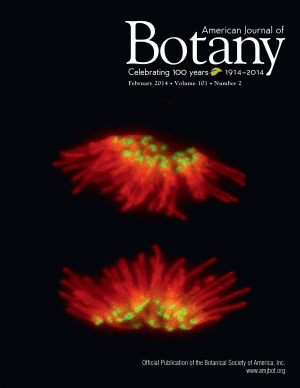This is the American Journal of Botany cover image; the issue contains the article by Brian Anacker on serpentine endemism. Credit: Image credit: Sylwia Oleszczuk.
Plants that live in unusual soils, such as those that are extremely low in essential nutrients, provide insight into the mechanisms of adaptation, natural selection, and endemism. A seminal paper by Arthur Kruckeberg from 1951 on serpentine plant endemism has served as a solid bedrock foundation for future research on the link between natural selection and speciation. A recent article in the American Journal of Botany focuses on how this paper has influenced subsequent research on local adaptation, evolutionary pathways, and the relationship between climate, soils, and endemism.
In the latest in a series of AJB Centennial Review papers, AJB Anacker (University of California, Davis) examines the impact that Kruckeberg's 1951 AJB paper has had on our subsequent understanding of plant evolution and ecology.
Kruckeberg's classic paper reported on reciprocal transplant experiments, in which he made several generalizations about plant competition, local adaptation, and speciation. Kruckeberg showed that the strong selective pressures of serpentine soils—characterized by low amounts of essential nutrients and water, and high in heavy metals—can lead to the formation of soil ecotypes (genetically distinct plant varieties), representing a possible first step in the evolution of serpentine endemism (e.g., plants that are only found on serpentine type soils). These important initial findings spurred subsequent research on determining plant traits (from molecular to organismal) that underlie serpentine adaptation.
Anacker draws attention to a second significant contribution of Kruckeberg's paper—researching the historic origins of endemic species, such as those found in serpentine soils. Anacker explains that endemic species are thought to originate in two ways: neoendemics are species that have formed relatively recently via nearby progenitor taxa, and paleoendemics are species that formed following habitat-specific population extirpation. Kruckeberg viewed serpentine ecotypes as representing the first step along the path of paleoendemism. While this stimulated much research in this area, Anacker points out that several serpentine endemics appear to have arisen from nearby progenitor taxa, and thus the neoendemic pathway is also likely important.
Interestingly, Kruckeberg's experiments also showed that many serpentine ecotypes actually performed better on the non-serpentine soils than on serpentine soils, which begs the question of why serpentine-adapted plants are not also found on non-serpentine soils. Anacker points out that Kruckeberg was one of the first to indicate that competition may play a key role in serpentine specialization. He also highlights recent research indicating that serpentine species are typically slow-growing stress tolerators rather than fast-growing competitive dominants, and their adaptations for being more drought-tolerant puts them at a disadvantage in soils where water and nutrients are not limiting.
While serpentine ecosystems are special and unique environments, Kruckeberg and subsequent researchers have shown how important these systems are for shedding light on broader aspects of plant ecology and evolution.
More information: Anacker, Brian L. 2014. The nature of serpentine endemism. American Journal of Botany 101(2): 219-224. www.amjbot.org/content/101/2/219.full.pdf+html
Journal information: American Journal of Botany
Provided by American Journal of Botany




















